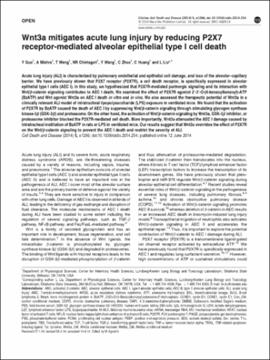| dc.contributor.author | Guo, Y. | |
| dc.contributor.author | Mishra, A. | |
| dc.contributor.author | Weng, T. | |
| dc.contributor.author | Chintagari, N. R. | |
| dc.contributor.author | Wang, Y. | |
| dc.contributor.author | Zhao, C. | |
| dc.contributor.author | Huang, C. | |
| dc.contributor.author | Liu, L. | |
| dc.date.accessioned | 2019-08-21T22:01:21Z | |
| dc.date.available | 2019-08-21T22:01:21Z | |
| dc.date.issued | 2014-06-12 | |
| dc.identifier | oksd_guo_wnt3amitigatesa_2014 | |
| dc.identifier.citation | Guo, Y., Mishra, A., Weng, T., Chintagari, N. R., Wang, Y., Zhao, C., ... Liu, L. (2014). Wnt3a mitigates acute lung injury by reducing P2X7 receptor-mediated alveolar epithelial type I cell death. Cell Death and Disease, 5(6). https://doi.org/10.1038/cddis.2014.254 | |
| dc.identifier.uri | https://hdl.handle.net/11244/321181 | |
| dc.description.abstract | Acute lung injury (ALI) is characterized by pulmonary endothelial and epithelial cell damage, and loss of the alveolar-capillary barrier. We have previously shown that P2X7 receptor (P2X7R), a cell death receptor, is specifically expressed in alveolar epithelial type I cells (AEC I). In this study, we hypothesized that P2X7R-mediated purinergic signaling and its interaction with Wnt/B-catenin signaling contributes to AEC I death. We examined the effect of P2X7R agonist 2'-3'-O-(4-benzoylbenzoyl)-ATP (BzATP) and Wnt agonist Wnt3a on AEC I death in vitro and in vivo. We also assessed the therapeutic potential of Wnt3a in a clinically relevant ALI model of intratracheal lipopolysaccharide (LPS) exposure in ventilated mice. We found that the activation of P2X7R by BzATP caused the death of AEC I by suppressing Wnt/B-catenin signaling through stimulating glycogen synthase kinase-3B (GSK-3B) and proteasome. On the other hand, the activation of Wnt/B-catenin signaling by Wnt3a, GSK-3B inhibitor, or proteasome inhibitor blocked the P2X7R-mediated cell death. More importantly, Wnt3a attenuated the AEC I damage caused by intratracheal instillation of BzATP in rats or LPS in ventilated mice. Our results suggest that Wnt3a overrides the effect of P2X7R on the Wnt/B-catenin signaling to prevent the AEC I death and restrict the severity of ALI. | |
| dc.format | application/pdf | |
| dc.language | en_US | |
| dc.publisher | Nature Publishing Group | |
| dc.rights | This material has been previously published. In the Oklahoma State University Library's institutional repository this version is made available through the open access principles and the terms of agreement/consent between the author(s) and the publisher. The permission policy on the use, reproduction or distribution of the material falls under fair use for educational, scholarship, and research purposes. Contact Digital Resources and Discovery Services at lib-dls@okstate.edu or 405-744-9161 for further information. | |
| dc.title | Wnt3a mitigates acute lung injury by reducing P2X7 receptor-mediated alveolar epithelial type I cell death | |
| osu.filename | oksd_guo_wnt3amitigatesa_2014.pdf | |
| dc.description.peerreview | Peer reviewed | |
| dc.identifier.doi | 10.1038/cddis.2014.254 | |
| dc.description.department | Physiological Sciences | |
| dc.type.genre | Article | |
| dc.type.material | Text | |
| dc.subject.keywords | tlr4 | |
| dc.subject.keywords | wnt3a | |
| dc.subject.keywords | ctnnb1 | |
| dc.subject.keywords | gsk3b | |
| dc.subject.keywords | p2rx7 | |
| dc.subject.keywords | p2rx7 | |
| dc.subject.keywords | wnt3a | |
| dc.subject.keywords | ctnnb1 | |
| dc.subject.keywords | acute lung injury | |
| dc.subject.keywords | death | |
| dc.subject.keywords | capillaries | |
| dc.subject.keywords | epithelial cells | |
| dc.subject.keywords | cells | |
| dc.subject.keywords | proteasome endopeptidase complex | |
| dc.subject.keywords | lipopolysaccharides | |
| dc.subject.keywords | receptors, purinergic p2x7 | |
| dc.subject.keywords | glycogen synthase kinases | |
| dc.subject.keywords | catenins | |
| dc.subject.keywords | receptors, death domain | |
| dc.subject.keywords | proteasome inhibitors | |
| dc.subject.keywords | cell death | |
| dc.subject.keywords | therapeutics | |
| dc.subject.keywords | in vitro techniques | |
| dc.subject.keywords | rattus norvegicus | |
| dc.subject.keywords | mus musculus | |
